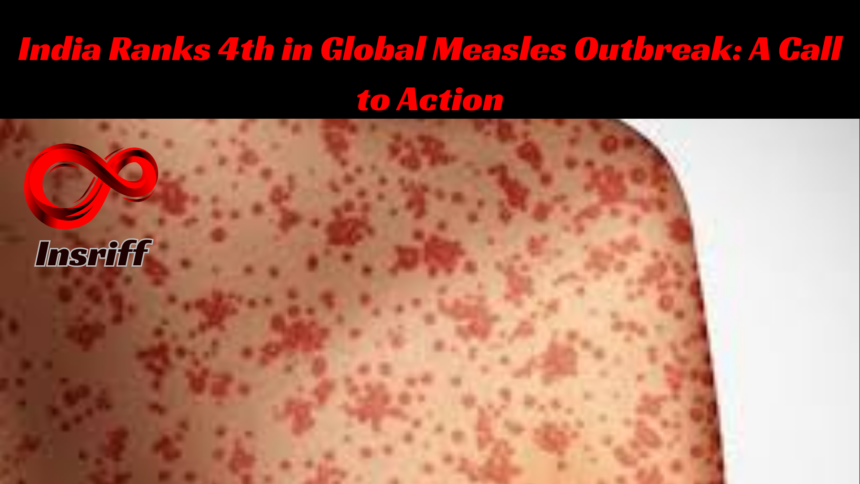Measles is a highly contagious viral infection that has emerged as a substantial public health threat globally and causing widespread morbidity and mortality, particularly in susceptible populations, including the young.
India is recognized for its advances in pharmaceutical medicine, but public health faces a grim reality: It has the fourth-highest measles cases globally, as the World Health Organization (WHO) noted.
This alarming revelation points to systemic weaknesses in India’s public fitness infrastructure, requiring timely and concerted efforts to address this crisis.
Modes of Transmission

Measles is usually spread through the respiratory tract by aerosol droplets exhaled by infected people. Close contact with an infected person increases the risk of transmission, especially in crowded or poorly ventilated environments. Additionally, the measles virus is in the air for long periods of time, which contributes to its contagiousness.
Causes of India’s Measles Crisis
There are the 3 main reasons that tell us that why measles spread in India, which are
1. Vaccine Hesitancy and Misinformation
2. Gaps in Routine Immunization
3. Socio-monetary Disparities
1. Vaccine Hesitancy and Misinformation
UNICEF states that poor vaccination rates and measles exposure are caused by exposure to unreasonable fear and mistrust of vaccines, which is frequently spread through social media channels.
2. Gaps in Routine Immunization
According to The Lancet, India’s vast and diverse geography affords the logistical imperatives to ensure comprehensive vaccination coverage. Remote areas, limited access to health care, and neglecting vaccination schedules increase susceptibility to measles outbreaks.
3. Socio-monetary Disparities
The Center for Disease Dynamics, Economics and Policy says disadvantaged groups face barriers to access to health care and less awareness of the benefits of vaccination, adding to the measles crisis. Economic factors play a prominent role in determining vaccination fees and health outcomes.
The outbreak of Measles
As of early February 2024, provisional facts stated that the World Health Organization (WHO) discovered a surge in measles instances throughout various international locations. Notably, Yemen, Azerbaijan, Kazakhstan, and India reported widespread cases in July and December 2023.
- Yemen: 18,464 instances
- Azerbaijan: 13,721 instances
- Kazakhstan: 13,195 cases
- India: 12,301 cases
- Ranking of India
India ranks fourth globally in showed measles instances, indicating the widespread nature of the outbreak. Children and infants are commonly affected, with urban and densely populated areas experiencing better prevalence due to improved population mobility and density.
- Role of COVID-19
The COVID-19 pandemic disrupted routine immunization requests, creating a gap in vaccination insurance. At the same time, misinformation about the measles vaccine similarly fueled the epidemic, complicating efforts to control its spread.
Results of the Measles Crisis in India:
1. Health Complications
Measles can bring about severe health results, inclusive of pneumonia, encephalitis (brain swelling), or even loss of life, mainly affecting prone populations, which include youngsters under 5 and those with constrained access to healthcare.
2. Economic Burden
According to the World Bank, measles outbreaks weaken healthcare systems and cause extraordinary financial costs due to treatment and productivity losses. The burden is particularly felt in aid-limited settings where healthcare resources are already stretched thin.
3. Global Implications
Due to worldwide tourism and interconnectedness, uncontrolled measles outbreaks in India have global implications. The risk of exporting instances to other countries underscores the significance of addressing the disaster comprehensively and collaboratively.
Common Symptoms
Following an incubation period of 10–12 days post-infection, individuals commonly showcase the following symptoms:
- High Fever: Fever is frequently one of the preliminary signs and symptoms of measles contamination and might spike to improved tiers.
- Skin Rash: A function rash appears on the body, often beginning on the face and spreading to other parts.
- Respiratory Symptoms: Running nose and cough are common breathing manifestations.
- Red Eyes: Conjunctivitis, or redness and irritation of the eyes, generally happens in measles-infected individuals.
- Oral Manifestations: Small white skin spots, called Koplik’s, can be seen on the cheeks.
Potential Complications:
While most people get better within 2–3 weeks, measles can cause severe headaches, including:
- Ear Infection: Measles increases the danger of central ear infections, which can cause aches and transient listening loss.
- Blindness: Inflammation of the optic nerve (optic neuritis) can result in imaginative and prescient impairment or blindness.
- Encephalitis: Measles, brought on by irritation of the mind (encephalitis), poses a big threat to neurological complications, such as seizures and cognitive deficits.
- Diarrhoea: Measles can result in gastrointestinal headaches, which include diarrhoea, especially in malnourished humans.
- Pneumonia: Secondary bacterial infections and pneumonia are commonplace headaches of measles and may be life-threatening.
- Death: Severe headaches of measles, which include encephalitis and pneumonia, can bring about fatalities, mainly amongst babies, younger kids, and immunocompromised individuals.
Symptoms usually last about five days before fading. However, complications from measles, including pneumonia and encephalitis, can result in excessive morbidity or death.
Impact of Measles on Pregnancy
Measles infection during pregnancy harms the mother and fetus. Complications can include premature birth or birth with low body weight. This is why it indicates that vaccination is a priority, especially for expectant mothers.
Conclusion
It will work with immediate action and continued dedication to address the causes of the measles epidemic. India has the potential to control the measles epidemic and move towards a healthier future by emphasizing immunization, debunking misinformation, and guaranteeing access to healthcare.
As a public health expert, I advise that coordinated action across multiple sectors is necessary to address the root causes, control the outbreak, and mitigate its impact. Prioritizing vaccination, combating misinformation, and advancing equity in health care admissions is critical.
REFERENCES:
FAQs
Q1: What is the number of measles cases in India?
Nowadays, India faces approximately 12,301 cases of measles.
Q2: In India, how many people die from measles?
Published measles epidemiological investigations were reviewed, and the results showed that the case-fatality ratio ranged from 0 to 23.9%, with a mean of 3.7%. India uses a formal national infectious disease reporting system to monitor measles morbidity and mortality.
Q3: Where did the measles outbreak originate?
One of the most transmissible diseases that people have ever encountered is measles. This is an ancient illness that was first documented in the ninth century by the Persian scholar and physician Abū Bakr Muhammad Zakariyyā Rāzī (also called Rhazes in Europe).









